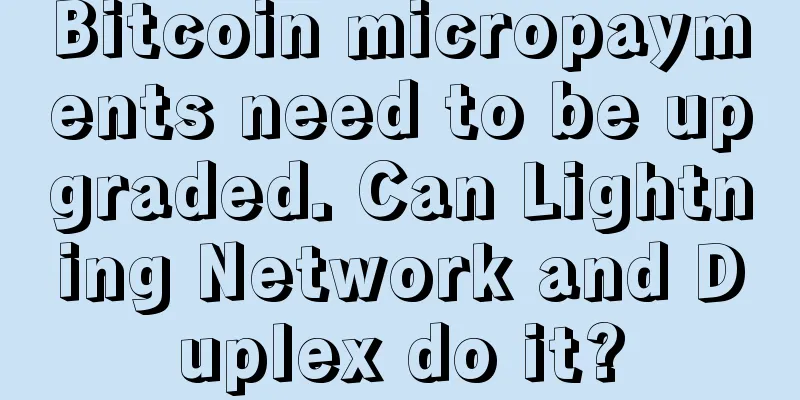Bitcoin micropayments need to be upgraded. Can Lightning Network and Duplex do it?

|
Bitcoin's ability as a micropayment protocol has a wealth of applications that are obvious to all. Compared to credit cards and PayPal, the latter's definition of small amounts is transactions less than about $5, while Bitcoin can be divided into 100 million tiny units, which we call Satoshi. According to the market price, 1 Satoshi is equivalent to $0.000002. Proponents have long speculated that this divisibility, combined with widespread bitcoin adoption, could create a situation where all forms of digital media, including existing advertising or event subsidies, could be paid for with bitcoin micropayments, thus replacing centralized media organizations from newspapers to streaming music services. If one were to quantify this untapped market, its size so far is actually quite small, according to estimates by Wedbush Securities, which has predicted that Bitcoin micropayments could be a $925 billion market by 2025. “Previously impractical electronic payments of less than $1 could broadly change the economics of online content, potentially crowding out advertising,” it said in a July report. Despite this, on today’s Bitcoin network, we still cannot send 1 satoshi at a reasonable price. “When you first read the bitcoin white paper, you think micropayments are magical, and then you realize that it doesn’t work,” developer Thaddeus Dryja told CoinDesk. For example, if a user wants to transfer $0.001 (400 satoshis) through the Bitcoin network, this is impossible. Currently, the minimum output of the Bitcoin network is “You need to spend 200 percent of what you actually spend,” Dryja points out. Still, Dryja is working to make sure bitcoin technology can deliver on its promise of micropayments. As co-founder of the bitcoin Lightning Network, Dryja and his partner Joseph Poon had a conversation about how bitcoin technology can be upgraded through payment channels. In its simplest form, a payment channel allows a user to send a certain amount of Bitcoin, such as $10, to a multi-signature wallet controlled by two parties. The channel will be represented on the blockchain, and its initial balance of funds will be established. The balance will then be adjusted between the parties, and when they make transactions, Bitcoin's nLockTime parameter will ensure that it does not enter a block before the specified time. Developers believe that this system replicates many of the positive benefits of Bitcoin - transactions can be completed without trusting a third party, while allowing most such (small) transactions to be taken off the main blockchain. It is reported that the Lightning Network development team is not the only one developing payment channels. A similar protocol is the Duplex Micropayment Channel (DMC) developed by the Distributed Computing Group of the Swiss Federal Institute of Technology in Zurich. In September, they released its white paper. Lightning Network Development ProgressCurrently, the Lightning Network is backed by Blockstream, a startup that raised $21 million in angel funding in late 2014 for its sidechain project, which aims to make blockchains interoperable. Rusty Russell, a core technical engineer at Blockstream, joined the company in March this year and is now working full-time on the Lightning Network project. In addition, Dryja and Poon are seeking to develop a formal business entity around the project without funding or corporate support. In the interview, Dryja and Poon argued that while the development of the project, which they determined could take years, the Lightning Network could be launched in as little as six months. In their view, the most pressing issue that needs to be addressed in the Lightning Network is decentralization, which is the most important complex factor in deployment. Poon said:
It is reported that the current version of the Lightning Network is written in Dryja said that testing of the Lightning Network is currently underway on Testnet3 (Bitcoin Test Network 3). Bigger Network Improvements To implement the Lightning Network, a Russell pointed out in his review of the April white paper that soft forks are needed to prevent The issue of transaction malleability, a process whereby transactions can be altered before they are included in the blockchain’s block data, is something the Lightning Network development team is confident will be resolved by the developer community. “Today, you can build a lightning network, but the current situation is that funds can be held hostage by one party, and locking up funds is not enough. It creates a hostage situation, and you want to minimize the trust required in the system,” Poon said. The emergence of DMCIn Europe, a multi-tier micropayment system is moving toward a similar goal. Christian Decker and Roger Wattenhofer, professors at ETH Zurich, proposed the concept of DMC in September. Decker told CoinDesk that the team has been conducting this research, and he believes that the Lightning Network and the DMC proposal can achieve secure "off-chain routing payments" for the first time. Although there are three major differences between the two. One of the core differences is that the Lightning Network requires private keys to change the state of the contract, while DMC uses decremental timelocks. Essentially, the DMC suggests that payment channel protocols could be upgraded by changing the scheduled time they are committed to the blockchain, rather than exchanging private keys to invalidate transactions. Decker believes this makes DMC easier to audit. “This is the core difference between DMC and the Lightning Network, where its parts are tightly coupled and individually unusable,” he said. Like the Lightning Network, the implementation of DMC also needs to solve the problem of transaction scalability. Decker also submitted a Bitcoin Improvement Proposal (BIP), which is still in the draft stage. According to the presentation, the research is currently moving forward and will be open source, and Decker also suggested that he believes the Lightning Network and DMC will be interoperable, meaning that users will one day be able to take advantage of both protocols simultaneously. Off-chain micropaymentsOf course, this is not the only example of micropayments. For example, ChangeTip is also a Bitcoin reward built in an off-chain way, and the social network ZapChain uses BlockCypher to dynamically insert small transactions. A more secretive and potentially more impactful project comes from bitcoin startup 21 Inc, which has raised $120 million, making it the most funded company in the bitcoin industry. Recently, 21 released a "Bitcoin computer". At the unveiling of the product, the company's president Balaji Srinivasan said:
It’s not clear whether such microtransactions would interact directly with the blockchain, but could happen off-chain or through 21’s ecosystem. Poon and Dryja said they have not yet had any contact with the company. “Most people, not technical people, think that Bitcoin is already doing this. In 2013, there were a lot of reports that people would say Bitcoin transactions are zero-fee and can do micropayments, but Bitcoin doesn’t really do that,” Dryja said. “A lot of people think you can do a lot of things with Bitcoin, and we’re doing that.” ---- |
<<: How long can the 21 Inc Bitcoin computer's micropayment story last?
>>: POS terminal giant Ingenico expands Bitcoin payment range globally
Recommend
China (unofficially) authorizes Bitcoin, price bullish
While many media and financial experts point to t...
Articulate and good at talking to others
There are many people who actually have relativel...
[Review] Litecoin Mining Pool Review | Issue 1 | Mining Pool Humanized Service
★The evaluation may be late, but it will never be...
What kind of man is most likely to be rich?
Physiognomy: What kind of man is most likely to b...
What is the best palmistry for women?
1. Women with many money lines are good at managi...
What kind of woman has the best fortune to marry a rich husband?
In addition to one's own eight-character fort...
What does long toes mean? How to tell your fate from the length of your toes
Our bodies and hair are inherited from our parent...
Is it good for a man to have prominent brow bones?
Is it good for a man to have prominent brow bones...
On the left-handed celebrities in palmistry
Louis Napoleon Bonaparte French Emperor of the Th...
Is it good for a woman to have a big forehead?
The forehead is very important in physiognomy. Th...
In physiognomy, eyebrows can be used to predict a person's character and life destiny.
Broken Heart Eyebrow People with Broken Eyebrows ...
Warmly celebrate the successful conclusion of the 2020 Supercomputing and Distributed Storage Industry Summit
On August 29, 2020, the "2020 Supercomputing...
The face of a man with three wives and four concubines
The face of a man with three wives and four concu...
How to tell a person's fortune from his neck
How to tell a person's fortune from his neck ...
Does the money-making logic behind platform coins really make sense?
The money-making logic behind platform coins When...









